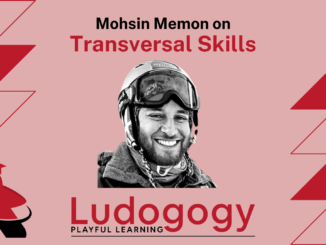
It may be fair to say that the educational process is not about large goals, graduations, and certifications but bite-sized improvements that compound over time. Some of these improvements resulted from educators who took a chance on a potentially disastrous lesson or learning experience, high risk, high reward. In my experience, take the risk. If you must stop because you ran out of time or resources, then c’est la vie; your students will be better for the journey
The journey I like taking my students through is the process of creating historical and narrative fiction. Just like a real journey, the process can be long, strenuous, unpredictable, and hopefully doesn’t end in tears. But not every time my class started a story, we finished it. While it’s satisfying to complete a student-made story with no loose ends, with a clear beginning, middle, and end, that’s not the main goal; the goal is the process. In other words, it doesn’t matter if you’ve not completed the story in your allotted time. It doesn’t matter if you haven’t perfected that compelling protagonist or figured out which friends become enemies, and which enemies become friends, or how your main character will be richer for the experience. What matters is you start the journey.
Why Stories?
The “journey,” or story-making process, allows educators to target and develop curriculum-specific skills while addressing students’ social and emotional needs. The process of creating rich, evidenced-based stories benefits students in several ways. First, we can use this process to build skills necessary for their future success, specifically analytical thinking, creative thinking, problem-solving, leadership, and collaboration. Second, stories are an excellent means of looking into the future, predicting, explaining, and understanding the world around us. We use them to encourage introspection, personal growth, and behavior change. Third, the process can be extremely fun. Literary devices such as hooks, character archetypes, and story archetypes allow students to customize their stories, increasing their buy-in, intrinsic motivation, and time on an assignment.
Skill Acquisition
The story-making process lends itself to skill acquisition in various ways. For one, educators can create situations where students must practice and develop targeted skills. Curriculum-friendly and highly sought-after skills such as analytical thinking, creative thinking, problem-solving, leadership, and collaboration can be woven into the story-making process; see the World Economic Forum’s list of Core Skills below. Second, different junctions of the “journey” allow for mastery checks, formative and summative assessments, and meaningful feedback. Third, students learn more when they are motivated. The creative process, in which students can express themselves and make crucial decisions, can be practical and fun.

How can you incorporate skills into the creation process? It depends. If you want students to conduct research or use primary and secondary sources, you can help students find and use reliable sources. If you would like students to practice analytical thinking, have them break a concept down into smaller parts, looking for patterns and underlying principles. Likewise, if you want students to collaborate, ensure they rely on each other. Stories are an exciting and effective way for students to learn new skills.
Growth Through Self-Expression
The story-making process is an opportunity to help students grow socio-emotionally through self-expression. This can start by simply encouraging students to make decisions along our journey. Which characters will be used? Where will they go? What will they do? According to counselor and therapist Janine Hodge, students who express themselves are likelier to experience good mental health, healthy connections, well-being, and respectful boundary setting within relationships.
Expression through stories allows students to test out their feelings and beliefs while maintaining plausible deniability. “It’s not me that feels that way; it’s our hero.” The creation of stories helps us achieve a deeper understanding of a given topic and also helps us make sense of the world and, more importantly, ourselves.
Starting a Story with Literary Devices
Start the story-creation process by choosing the general story context. As a former social studies teacher, this would be the time and place we discuss in class, e.g., The Aztec Empire in Mesoamerica. However, a science teacher may choose something like the Center for Disease Control (CDC) or “your immune system,” while a French teacher may choose a trip to The Louvre. The creative process has already started!
Next is research; make sure your students have some good primary and secondary sources to draw inspiration and ensure this work of fiction is as accurate as possible. This will improve a student’s ability to use reliable sources and extract information from a text. This can also be a fun time to start brainstorming ideas regarding a story’s who, what, when, where, and why.
The literary devices below will help you get a start on your story. They are by no means the only three things you may need to write a story, but it’s a good start. Use character archetypes, the shape of our stories, and hooks to draw inspiration and get the creative juices flowing.
Archetypes

One fun way of developing a story and allowing students to express themselves is using archetypes. Archetypes are the recurring symbols, people, and storylines in literature, painting, or mythology. Psychologist Carl Jung said archetypes are collectively inherited unconscious ideas and thought patterns universally present in individual psyches. Stories can have character and story archetypes, but it may be helpful to consider them story prototypes. Some evolutionary theorists believe archetypes result from evolutionary dynamics and personal experiences, adaptive responses to social problems. Classic characters and storylines emerge out of dynamics and classic problems. See the Character Archetype wheel to the right.
Character Archetypes
Character archetypes allow us to create rich, historically accurate characters that our students can love, hate, or relate to. You and your students can create exciting protagonists, antagonists, heroes, anti-heroes, and red herrings with backgrounds, flaws, depth, and arches. Think of the most compelling characters of all time. My list includes Dr. Hannibal Lector, Tyler Durden, Ellen Ripley, Lt. Aldo Raine, Mickey “The One-Punch Machine Gun” O’Neil, Jules Winnfield, Anton Chigurh, and Kaiser Söze. Do they fall nicely within one of the above classical archetypes? Or do they represent more than one classic archetype? And if you do not know who these characters are, I envy you, for you have some great stories in your future, but proceed cautiously.
To make sense of a character archetype, consider the stereotypical people you might see in a given context. Who were the people who inhabited Classical Athens; who would come to mind? The “sage” or scholar, a figure like Socrates, Plato, or Aristotle, the “ruler” or elected official or power-hungry politician. An “everyman,” in this case, could be a street merchant, sailor, or fisherman, or any sort of common person. If the context of your story is Japan in the 1500s, it may feature a young samurai seeking mastery over his craft, which we may classify as a hero. Likewise, in any culture or time, you may find someone seeking safety, classified as an ‘innocent”. An individual seeking liberation fits the classic “outlaw” archetype. But it’s not just the characters that make our story compelling; sometimes, it’s the shape of those stories.
Story archetypes
Story Archetypes, like character archetypes, are common themes of human experience. Classic stories of conflict, whether person vs. person or person vs nature, link to issues of survival and protection. Each structure may also model skills valuable to our prosperity, including communication, teamwork, and coordination. Consider the “hero’s journey,” in which the main character leaves what is known to him/her, finds mentors, and overcomes challenges. There is a reason this story has been told many times, in many ways, because it’s relatable.
Kurt Vonnegut argued in his Master’s defense that stories can be easily plotted on an X and Y Axis. The X-axis represents the story’s duration, from beginning to end, while the Y-axis represents fortune; near the top, you have health, riches, and prosperity, while near the bottom, you have poverty, disease, and despair. The University of Chicago rejected Vonnegut’s idea because it was “so simple,” but that doesn’t mean he was entirely wrong. Consider the classic story of “Man in Hole,” seen above. As Vonnegut explains, “It needn’t be about a man, and it needn’t be about somebody getting into a hole,” in which someone, considered above average, gets into trouble and then gets out of it again. “People love that story; they never get sick of it,” Vonnegut added. Some examples of this storyline are The Hobbit, Alice in Wonderland, and Finding Nemo. Another classic shape is Boy Meets Girl, but it needn’t be about a boy or a girl; that’s just a way to remember it. In this classic shape, the main character, an average person on an average day, finds something wonderful, then loses it and gets it back again, sort of. Think Romeo and Juliet or 500 Days of Summer. There are more classic examples of these story archetypes, including Rags to Riches Overcoming the Monster, Voyage and Return, Comedy, Tragedy, Rebirth, Which Way is Up, From Bad to Worse, etc. The archetype, or shape, will have different names depending on the sources.

Archetypes are frameworks at our disposal to create rich and immersive stories with students. It’s an opportunity to create classic tales that have stood the test of time because of their cross-cultural relevance. They also allow valuable social simulations, a safe way for students to practice skills. For example, if you fail to recognize a character in a story as a charlatan, there are few consequences in the classroom, but if that happens in real life, it may take an emotional toll or cause financial loss. However, the character and story archetypes aren’t enough, its important to keep the story exciting. This can be done through a hook.
Hook
Lesson plans, like good stories, often include a hook, defined by Merriam-Webster Dictionary as the “selling point.” The hook is where the story becomes meaningful, moving beyond attention to voluntary self-engagement. Teachers, writers, and storytellers use hooks to capture a wide range of emotions, including curiosity, uncertainty, anticipation, surprise, wonder, imagination, amusement, and amazement. Think of the beginning of your favorite story; what did the creator do to draw you in? Ray Bradbury starts Fahrenheit 451 with, “It was a pleasure to burn.” George Orwell, in 1984, opens with, “It was a bright cold day in April, and the clocks were striking 13.” Not 15 minutes into the 3-hour Saving Private Ryan, the Allied troops land on Omaha Beach, giving the audience a horrific look into the realities of D-Day. The opening scene of Cormack McCarthy’s No Country for Old Men exposes the audience to the nature of Anton Chigurh, giving them a hint of why there is, in fact, no country for old men. Fueled by emotion, hooks heighten responses to stimuli, increasing one’s ability to learn and retain information, and not to mention, they’re very fun.
Conclusion

Writing historical or narrative fiction stories with students can be long, complicated, and exhausting. However, this process helps with skill acquisition and socio-emotional growth. Literary devices such as archetypes and hooks add rich details to the characters and storyline, making it relatable, the characters lovable or hateable, resulting in immersive, unforgettable stories that help our students empathize with one another while encouraging introspection and personal growth. Stories do take a long time; they are unpredictable, but like most journeys, you’ll be better for it.
- Start the Journey - 24th January 2024





Be the first to comment